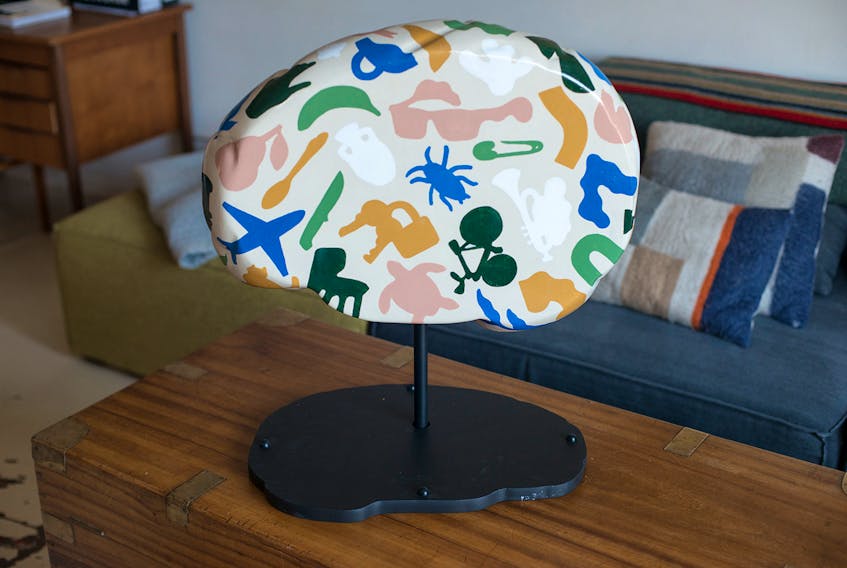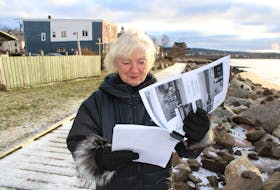TORONTO, Ont. — Alzheimer’s and other forms of dementia wreak havoc on the lives of people living with the diagnosis, and their loved ones. Toronto resident Shayla Bond, originally from Kentville, turned to art to encapsulate what she described as the “slow fade into the complicated mind of the Alzheimer’s patient.”
Mental health is an important point of focus for Bond, who maintains a balance in life by harnessing her enormous creativity and managing her attention deficit disorder (ADD) and the stressful demands of her career. The ability to spread awareness of mental illness through art resonated with her.
“The shapes are clear at first in the art piece. They’re silhouettes of things,” Bond said, describing her artwork to Kings County News in a July 31 phone call. “The brain uses logic to fill in the negative space but, slowly, as it fades into Alzheimer’s you can see the shapes shift and become ambiguous.”
This gradual ambiguity creates confusion and anxiety – emotions associated with the suffering of those who live with Alzheimer’s.
“Using art to raise awareness of mental health also parallels the benefits of art therapy to Alzheimer’s patients, encouraging them to use the right side of their brain,” Bond said. “Overall it came quite naturally and I’m happy how it turned out.”
All of this imagery she created is, appropriately enough, painted onto a sculpture of a brain.
This painted brain sculpture is one of many arranged in one of Toronto’s largest downtown green spaces.
MENTAL HEALTH
Bond is one of 50 artists whose work is on display in David Nathan Phillips Sqare Pond. They will later be put on display in a number of other public spaces in Toronto. They are all participants in the Yogen Früz Brain Project. The brain Bond painted is one of many Brainstallations on display until Aug 31.
The project is a rallying cry to raise brain health awareness and advance research on aging and dementia.
The Baycrest Foundation, the company behind the initiative, worked with local and international artists and celebrities to create thought-provoking pieces of art, all in the interest of making people aware of the importance of brain health.

564,000 Canadians live with Alzheimer’s and other forms of dementia. According to the Baycrest Foundation, dementia is not an inevitable or natural consequence of aging. There are numerous ways to help reduce the risk of cognitive decline. Baycrest researches early detection techniques for dementia. It’s Brainstallations project helps raise awareness and support its research.
CONCEPT
The concept for her artwork came to Bond quickly, naturally – and spontaneously.
“I already had a concept in place when I started, and normally when I paint I just go in without much of a concept,” Bond said. “I just go where my mind takes me.”
The project took about a week in its entirety to do, starting with stenciled-in designs, painting in, and eventually the matte finish.
Bond, who works full-time as a freelance commercial illustrator, drew upon two things from her day job to create her design; her affinity for the artistic, and the stress and anxiety of her line of work.
“Stress and anxiety are, you could say, pandemic. People are familiar with them in today’s workplace,” Bond said.
Although most vocational work is web and graphic design, she was always fond of traditional painting. That drove her decision to paint the design she came up with on her sculpture.
“I’m always hyperactive with ADD, so I have trouble concentrating,” Bond said.
That trouble concentrating diminishes very quickly when Bond paints, since she is able distance herself from the roar and rush of her everyday thoughts and focus on the task at hand.
“When I paint, there’s a drastic change in my overall movements and it’s one of the few times it’s not easy to notice if I’m in the room,” Bond said with a chuckle. “I focus solely on the perfect line or shape.”
She is fond of odd-shaped compositions and playing with colour studies when painting traditionally.
“I’m not ruminating when I paint. I’m meditating and focusing,” Bond said. “I slow myself down when painting.”
Bond cherishes this ability to slow herself down and notes that it’s a great way to take control of her own mental health, “in a way that isn’t yoga, or exercise or something that works for everybody else.”
INSPIRATION STRIKES
The original inspiration for Bond’s work came a full year before she signed up to create her brain sculpture.
“I actually took interest in the project in Toronto a few years back, lining the walkway of Trinity-Bellwoods Park,” Bond said. “I thought that was really cool, but it was only last year that I knew you could apply.”
Bond marked the date for when applications were accepted the following year.
“With ADD, it’s all about ‘routine, routine, routine.’ I write down everything and made sure the date was on the calendar,” Bond said.
“I thought the project was an excellent way to give back to the community in an expressive manner. The use of art to direct attention to an important issue is an awesome direct experience.”
The feedback on her project has been unanimously positive, and “amazing,” Bond said.
“I’m glad I was chosen to participate and spread the message and raise funds. I felt participating in something like this promotes preventative measures we can take,” she said. “Art can shape a regularly functioning brain and benefit those with Alzheimer’s and dementia.”
Shayla Bond’s brain sculpture is one of many vying for the people’s choice award. To vote for her artwork, visit http://www.brainproject.ca/2019-artists/









